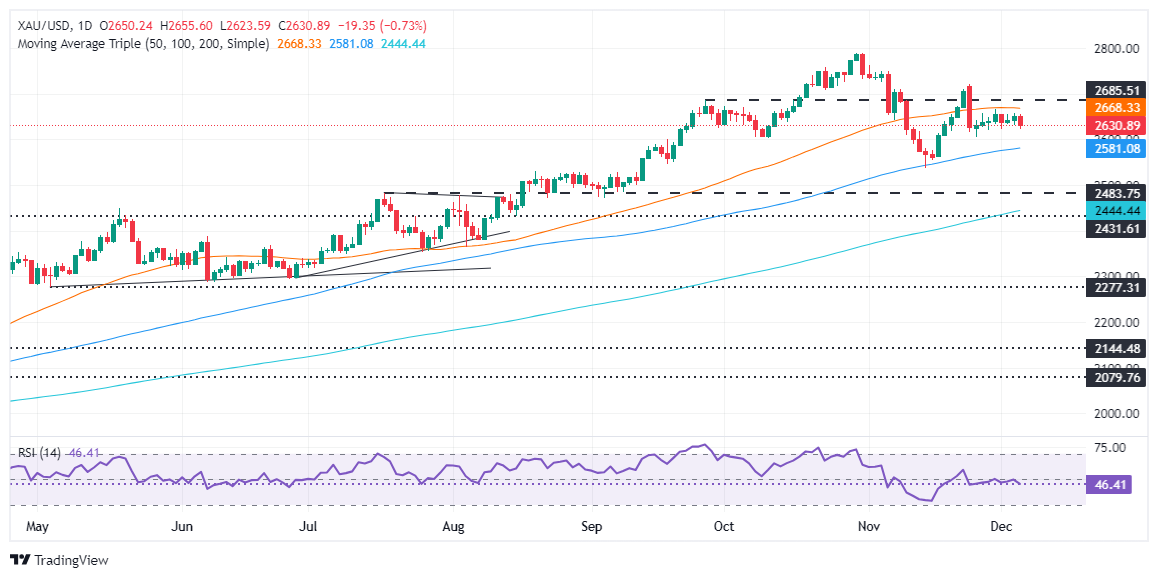- Gold price drops as rising US Treasury yields diminish its appeal amidst uncertain Fed actions.
- Mixed US jobless claims data contribute to market volatility ahead of crucial Nonfarm Payrolls release.
- Fed Chair Powell's optimistic economic assessment tempers expectations for imminent rate cuts.
Gold price retreats on Thursday as investors digested the latest US jobless claims data, ahead of the release of November’s Nonfarm Payrolls figures. A jump in US Treasury bond yields weighed on the yellow metal, which dropped 0.85%, trading at $2,626.
XAU/USD dips as US Treasury bond yields rise while traders trim bets that the US Federal Reserve (Fed) will lower borrowing costs by 25 basis points (bps) at the upcoming December meeting. Nevertheless, the mixed US jobs data revealed during the week kept investors uncertain about the outcome of the Fed’s decision.
Earlier, the US Department of Labor revealed that jobless claims for the last week exceeded the consensus, and the week ending on November 23 figures. At the same time, the US Bureau of Economic Analysis announced that the US trade deficit narrowed in October.
Bullion prices were capped by Fed Chair Jerome Powell’s comments on Wednesday. He said the economy remains robust, adding that he feels “very good about where the economy is and where monetary policy is.” Powell commented that the central bank “can afford to be a little more cautious as we try to find neutral.”
According to CME FedWatch Tool data, expectations that the Fed would cut rates at the December 17-18 meeting remain at 70%. However, Fed policymakers remained muted in their support for further easing, as next week’s inflation data would provide additional hints on the status of the distillation process.
Traders eye the release of November’s Nonfarm Payroll figures alongside the University of Michigan Consumer Sentiment.
Daily digest market movers: Gold price drops despite soft Initial Jobless Claims data
- Gold prices advanced as US real yields rose one basis point to 1.91%.
- The US 10-year Treasury bond yield is up one basis point to 4.18%.
- The US Dollar Index, which tracks the buck's performance against six currencies, stumbles 0.51% to 105.80 on the day.
- Initial Jobless Claims in the US increased by 9K to 224K for the week ending November 30, surpassing expectations of 215K, with the 4-week moving average climbing to 218.3K.
- The US trade deficit narrowed sharply in October to $73.8 billion, down from $83.8 billion in September, according to the Bureau of Economic Analysis.
- Data from the Chicago Board of Trade, via the December fed funds rate futures contract, shows investors estimate 19 bps of Fed easing by the end of 2024.
- Fed speakers crossed the newswires. St. Louis Fed President Alberto Musalem said that time might be near to slow or pause rate cuts. Richmond Fed’s Thomas Barkin said that risks for inflation and maximum employment remain balanced.
Technical outlook: Gold price consolidates between $2,600 and the 50-day SMA
Gold price remains consolidated after failing to register successive series of higher highs and lower lows, capped by the 50-day Simple Moving Average (SMA) at $2,667 on the upside. On the downside, XAU/USD failed to drop below the $2,620 figure, which could expose the $2,600 figure once cleared.
Momentum suggests that sellers are gathering some steam, as depicted by the recently turned bearish Relative Strength Index (RSI).
With that said, if XAU/USD slumps below $2,600, it will expose the confluence of an upslope support trendline and the 100-day Simple Moving Average (SMA) at $2,580, followed by the November 14 daily low and intermediate support at $2,536.
Conversely, if Gold reclaims $2,650, the next resistance would be the 50-day SMA. Once cleared, the next resistance would be $2,700, followed by the record high of $2,790.
Employment FAQs
Labor market conditions are a key element to assess the health of an economy and thus a key driver for currency valuation. High employment, or low unemployment, has positive implications for consumer spending and thus economic growth, boosting the value of the local currency. Moreover, a very tight labor market – a situation in which there is a shortage of workers to fill open positions – can also have implications on inflation levels and thus monetary policy as low labor supply and high demand leads to higher wages.
The pace at which salaries are growing in an economy is key for policymakers. High wage growth means that households have more money to spend, usually leading to price increases in consumer goods. In contrast to more volatile sources of inflation such as energy prices, wage growth is seen as a key component of underlying and persisting inflation as salary increases are unlikely to be undone. Central banks around the world pay close attention to wage growth data when deciding on monetary policy.
The weight that each central bank assigns to labor market conditions depends on its objectives. Some central banks explicitly have mandates related to the labor market beyond controlling inflation levels. The US Federal Reserve (Fed), for example, has the dual mandate of promoting maximum employment and stable prices. Meanwhile, the European Central Bank’s (ECB) sole mandate is to keep inflation under control. Still, and despite whatever mandates they have, labor market conditions are an important factor for policymakers given its significance as a gauge of the health of the economy and their direct relationship to inflation.
Information on these pages contains forward-looking statements that involve risks and uncertainties. Markets and instruments profiled on this page are for informational purposes only and should not in any way come across as a recommendation to buy or sell in these assets. You should do your own thorough research before making any investment decisions. FXStreet does not in any way guarantee that this information is free from mistakes, errors, or material misstatements. It also does not guarantee that this information is of a timely nature. Investing in Open Markets involves a great deal of risk, including the loss of all or a portion of your investment, as well as emotional distress. All risks, losses and costs associated with investing, including total loss of principal, are your responsibility. The views and opinions expressed in this article are those of the authors and do not necessarily reflect the official policy or position of FXStreet nor its advertisers. The author will not be held responsible for information that is found at the end of links posted on this page.
If not otherwise explicitly mentioned in the body of the article, at the time of writing, the author has no position in any stock mentioned in this article and no business relationship with any company mentioned. The author has not received compensation for writing this article, other than from FXStreet.
FXStreet and the author do not provide personalized recommendations. The author makes no representations as to the accuracy, completeness, or suitability of this information. FXStreet and the author will not be liable for any errors, omissions or any losses, injuries or damages arising from this information and its display or use. Errors and omissions excepted.
The author and FXStreet are not registered investment advisors and nothing in this article is intended to be investment advice.
Recommended content
Editors’ Picks

Gold remains within striking distance of new record-high above $3,300
Gold clings to strong daily gains above $3,300 after setting a new all-time peak near $3,320 earlier in the day. Continued concerns over the escalating US-China trade tensions and a weakening Greenback, support the demand for the metal prior to Powell's speech.

EUR/USD remains consolidative around 1.1350 on firmer US Retail Sales
EUR/USD maintains its daily gains around the 1.1350 region on the back of the resumption of the bearish tone in the Greenback, which showed no reaction to the stronger-than-expected Retail Sales in March. Later in the day, investors are expected to closely follow Fed Chairman Powell’s comments on the economic outlook.

GBP/USD recedes from tops and revisits the 1.3250 zone
GBP/USD extends its positive streak on Wednesday, now coming under some selling pressure around the 1.3250 after earlier multi-month tops around the 1.3300 mark. The daily uptick comes on the back of the weaker US Dollar and easing inflationary pressure in the UK.

Bitcoin stabilizes around $83,000 as China opens trade talks with President Trump’s administration
Bitcoin price stabilizes around $83,500 on Wednesday after facing multiple rejections around the 200-day EMA. Bloomberg reports that China is open to trade talks with President Trump’s administration.

Future-proofing portfolios: A playbook for tariff and recession risks
It does seem like we will be talking tariffs for a while. And if tariffs stay — in some shape or form — even after negotiations, we’ll likely be talking about recession too. Higher input costs, persistent inflation, and tighter monetary policy are already weighing on global growth.

The Best brokers to trade EUR/USD
SPONSORED Discover the top brokers for trading EUR/USD in 2025. Our list features brokers with competitive spreads, fast execution, and powerful platforms. Whether you're a beginner or an expert, find the right partner to navigate the dynamic Forex market.




